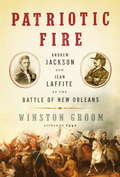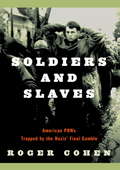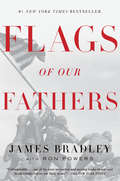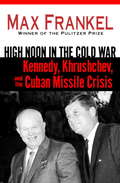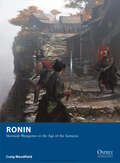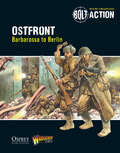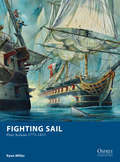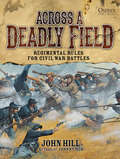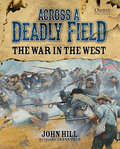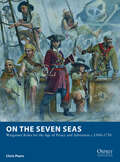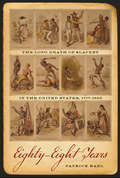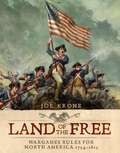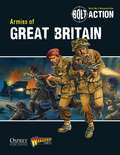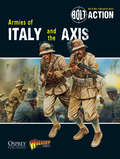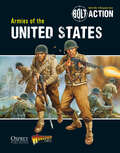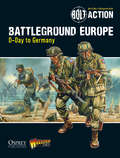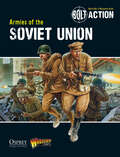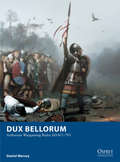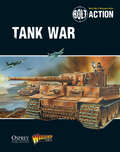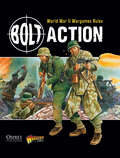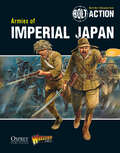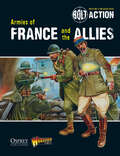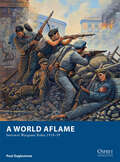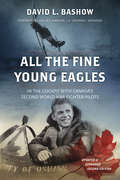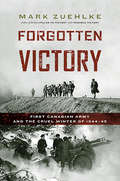- Table View
- List View
Patriotic Fire: Andrew Jackson And Jean Laffite At The Battle Of New Orleans (Playaway Adult Nonfiction Ser.)
by Winston GroomGroom recounts the Battle of New Orleans, in which Andrew Jackson joined French pirate Jean Lafitte to fight against the British invasion of the city in December of 1814. He discusses what led up to the battle, its stages, Jackson's and the British strategy, and how the British tried to recruit Lafitte. Groom is the author of 13 other books on historical and fictional subjects, including Forrest Gump, and was nominated for a 1984 Pulitzer Prize. Annotation ©2006 Book News, Inc. , Portland, OR (booknews. com)
Soldiers and Slaves
by Roger CohenIn February 1945, 350 American POWs captured earlier at the Battle of the Bulge or elsewhere in Europe were singled out by the Nazis because they were Jews or were thought to resemble Jews. They were transported in cattle cars to Berga, a concentration camp in eastern Germany, and put to work as slave laborers, mining tunnels for a planned underground synthetic-fuel factory. This was the only incident of its kind during World War II. Starved and brutalized, the GIs were denied their rights as prisoners of war, their ordeal culminating in a death march that was halted by liberation near the Czech border. Twenty percent of these soldiers–more than seventy of them–perished. After t_he war, Berga was virtually forgotten, partly because it fell under Soviet domination and partly because America’s Cold War priorities quickly changed, and the experiences of these Americans were buried. Now, for the first time, their story is told in all its blistering detail. This is the story of hell in a small place over a period of nine weeks, at a time when Hitler’s Reich was crumbling but its killing machine still churned. It is a tale of madness and heroism, and of the failure to deliver justice for what the Nazis did to these Americans. Among those involved: William Shapiro, a young medic from the Bronx, hardened in Normandy battles but, as a prisoner, unable to help the Nazis’ wasted slaves, whose bodies became as insubstantial as ghosts; Hans Kasten, a defiant German-American who enraged his Nazi captors by demanding, in vain, that his fellow U. S. prisoners be treated with humanity, thus committing the unpardonable sin of betraying his German roots; Morton Goldstein, a garrulous GI from New Jersey, shot dead by the Nazi in charge of the American prisoners in an incident that would spark intense debate at a postwar trial; and Mordecai Hauer, the orphaned Hungarian Jew who, after surviving Auschwitz, stumbled on the GIs in the midst of the Holocaust at Berga and despaired at the sight of liberators become slaves. Roger Cohen uncovers exactly why the U. S. government did not aggressively prosecute the commandants of Berga, why there was no particular recognition for the POWs and their harsh treatment in the postwar years, and why it took decades for them to receive proper compensation. Soldiers and Slaves is an intimate, intensely dramatic story of war and of a largely forgotten chapter of the Holocaust.
Flags of Our Fathers: A Young People's Edition (Playaway Adult Nonfiction Ser.)
by James Bradley Ron PowersIn this unforgettable chronicle of perhaps the most famous moment in American military history, James Bradley has captured the glory, the triumph, the heartbreak, and the legacy of the six men who raised the flag at Iwo Jima. Here is the true story behind the immortal photograph that has come to symbolize the courage and indomitable will of America. In February 1945, American Marines plunged into the surf at Iwo Jima—and into history. Through a hail of machine-gun and mortar fire that left the beaches strewn with comrades, they battled to the island's highest peak. And after climbing through a landscape of hell itself, they raised a flag. Now the son of one of the flagraisers has written a powerful account of six very different young men who came together in a moment that will live forever. To his family, John Bradley never spoke of the photograph or the war. But after his death at age seventy, his family discovered closed boxes of letters and photos. InFlags of Our Fathers, James Bradley draws on those documents to retrace the lives of his father and the men of Easy Company. Following these men's paths to Iwo Jima, James Bradley has written a classic story of the heroic battle for the Pacific's most crucial island—an island riddled with Japanese tunnels and 22,000 fanatic defenders who would fight to the last man. But perhaps the most interesting part of the story is what happened after the victory. The men in the photo—three were killed during the battle—were proclaimed heroes and flown home, to become reluctant symbols. For two of them, the adulation was shattering. Only James Bradley's father truly survived, displaying no copy of the famous photograph in his home, telling his son only: "The real heroes of Iwo Jima were the guys who didn't come back. " Few books ever have captured the complexity and furor of war and its aftermath as well asFlags of Our Fathers. A penetrating, epic look at a generation at war, this is history told with keen insight, enormous honesty, and the passion of a son paying homage to his father. It is the story of the difference between truth and myth, the meaning of being a hero, and the essence of the human experience of war.
High Noon in the Cold War
by Max FrankelOne of the giants of American journalism now re-creates an unforgettable time–in which the whole world feared extinction. High Noon in the Cold Warcaptures the Cuban Missile Crisis in a new light, from inside the hearts and minds of the famous men who provoked and, in the nick of time, resolved the confrontation. Using his personal memories of covering the conflict, and gathering evidence from recent records and new scholarship and testimony, Max Frankel corrects widely held misconceptions about the game of “nuclear chicken” played by John Kennedy and Nikita Khrushchev in October 1962, when Soviet missiles were secretly planted in Cuba and aimed at the United States. High Noon in the Cold Warportrays an embattled young American presidentnot jaunty and callow as widely believed, but increasingly calm and statesmanlikeand a Russian ruler who was not only a “wily old peasant” but an insecure belligerent desperate to achieve credibility. Here, too, are forgotten heroes like John McCone, the conservative Republican CIA head whose intuition made him a crucial figure in White House debates. In detailing the disastrous miscalculations of the two superpowers (the U. S. thought the Soviets would never deploy missiles to Cuba; the Soviets thought the U. S. would have to acquiesce) and how Kennedy and Khrushchev beat back hotheads in their own councils, this fascinating book re-creates thewholestory of the scariest encounter of the Cold War, as told by a master reporter.
Ronin - Skirmish Wargames in the Age of the Samurai
by Craig Woodfield Jose Daniel PenaRonin is a set of skirmish wargame rules set in late 16th century feudal Japan. Players build small warbands of models and battle each other as well as non-player factions in duels and skirmishes. Ronin is historically accurate, but also pays tribute to the films of Akira Kurosawa such as Seven Samurai and Yojimbo.Despite the enduring popularity of this period, there are very few widely available historical samurai skirmish wargames rules sets. Figures for the period are increasingly available, particularly from Perry Miniatures (very high quality 28mm metal), Wargames Factory (plastic 28mm box sets) and Zvezda (1/72 plastic). Ronin seeks to fill this void with an enjoyable system that is easy and cheap to take up. Gameplay is based upon a d6 system that forces players to make tactical decisions about attack and defence, simulating the cut and thrust of hand-to-hand combat.There are numerous player factions, from Samurai and Ashigaru, the professional soldiers of the period, to Buddhist warrior monks, martial arts schools, and bandits.There are also swords for hire such as Ronin and ninja that players can hire to augment their warband.Players design their warband using a points system, and assign each model weapons, armour and martial skills. Weapons include the yari (pike/spear), naginata (pole arm), yumi (bow), arquebus and of course the katana and its variants. Specialist skills allow a model to undertake various special actions (for example, arrow-cutter provides additional defence against bow fire) or increases the proficiency of the model with a specific weapon.As well as straight warband-on-warband battles, there are specific scenarios, some of them linked to provide a loose narrative. Gameplay is based upon a d6 system that forces players to make tactical decisions about attack and defence, simulating the cut and thrust of hand-to-hand combat. One scenario features the warband defending a notable person from attack by ninjas, another the defence of a village against bandits. There are also campaign rules that allow for the development of a warband in terms of gaining new skills and equipment and planning on-going battles against other players. Finally, very simple guidelines for running a tournament are included.
Bolt Action: Ostfront
by Peter Dennis Warlord GamesTake charge of Operation Barbarossa and drive towards Moscow or command the steadfast defenders of the Soviet Union. From the early battles for Leningrad and Sevastopol to the tank clash of Kursk and the bitter urban warfare of Stalingrad, this new theatre supplement for Bolt Action provides players with new scenarios and special rules that give them everything they need to focus their gaming on the Eastern Front.
Fighting Sail - Fleet Actions 1775-1815
by Peter Dennis Ryan MillerIn the years between 1776 and 1815, grand square-rigged sailing ships dominated warfare on the high seas. Fighting Sail is a tabletop wargame of fleet battles in this age of canvas, cannon, and timbers. Players take on the roles of fleet admirals from one of eight different national fleets: America, Britain, France, Spain, The Netherlands, Portugal, Russia and Sweden in battles ranging from the American War of Independence to the Napoleonic Wars and the War of 1812. Each fleet has access to different ships, tactics, and command personalities - each with its own strengths and weaknesses. Offering a unique blend between detail and simplicity, the scenarios included enable the recreation of historic actions or 'what-if' scenarios. Join the battle and experience the adventurous age of the fighting sail!
Across A Deadly Field - Regimental Rules for Civil War Battles
by John HillManassas, Shiloh, Gettysburg, Atlanta, and Petersburg are just a few of the many large scale Civil War battles that gamers enjoy simulating on the tabletop. Up until now, CW (Civil War) games have either taken a regimental approach for a more tactical game or a brigade-level view for a more grand tactical game - and gamers have plenty of both regimental or brigade level CW rule sets to choose from. However, both approaches have drawbacks. The pure regimental approach - such as in Johnny Reb - can make it difficult to fight a very large battle, while the brigade approach often fails to capture the unique feel of the CW where the actions of one regiment - such as the 20th Maine at Little Round Top - could turn a battle. Across A Deadly Field offers a game system that enables gamers to fight large battles in a relatively compact space, yet maintains the regimental focus and flavor appropriate to the conflict. Across A Deadly Field uses a scale that can be described as a "telescoped" version of Johnny Reb III - with twice the ground and figure scale, and has individual regiments and batteries as the base element of maneuver:- Ground Scale: 1" = 100 yards- Time Scale: 1 turn = 20 minutes- Regiment Scale: Two stands/bases per regiment- Figure Scale: 1 figure = 60 men- Gun scale: 1 gun = 1 batteryThe big advantage of this approach is that the gamer is not required to rebase any figures from his existing Johnny Reb army, allowing for much easier conversion from the older game to Across A Deadly Field. The existing four-stand regiments become two different regiments of two stands each - his miniature army has, for gaming purposes, just doubled. This will hold an appeal for many gamers - they can either recreate smaller engagements in half the space that would once have been needed, or can game huge battles on a table that would once have only accommodated a small skirmish. In essence, Across A Deadly Field offers two games with a single, consistent basing system.
Across A Deadly Field - The War in the West
by Mark Stacey John HillThe War in the West, the new supplement for Across A Deadly Field brings to the tabletop the bitter struggles of the Western Theatre of the American Civil War. The special rules and scenarios included in this volume give players everything they need to recreate the battles, both great and small, of this theatre of the war. Battles such as Shiloh, Stone River, Vicksburg, Chickamauga, Chattanooga and Atlanta are presented in great detail, offering players of Across a Deadly Field not only a range of scenario options, but the ability to play through a full campaign.
On the Seven Seas
by Steve Noon Chris PeersOn the Seven Seas is a set of wargames rules covering the high adventure and low morals of the world of the pirate. From Drake and his sea-rovers to Blackbeard, the Barbary Corsairs and the Wo-k'ou of the Far East, pirates have haunted seas across the globe, preying on port and vessel alike. Now you too can recreate the exploits of pirate captains or the naval commanders that hunted them. Whether you want skirmishes between crews on uncharted islands and in the alleyways of Caribbean ports or ship-to-ship duels that culminate in bloodthirsty boarding actions, the rules offer a quick-to-learn basic game. These small forces of buccaneers, commanded by captains and kept in line by trusted lieutenants, can also be scaled up with ease for larger engagements. Gameplay centers on two driving motivations that epitomize the pirate life - Fear and Greed. Cunning captains will have to balance these two elements, instilling fear in their opponents with bloodthirsty reputations, while keeping their own crews in line with the promise of loot and wealth.
Lion Rampant - Medieval Wargaming Rules
by Mark Stacey Daniel MerseyLion Rampant is a set of rules designed for fighting historical or Hollywood battles in the medieval period from the Norman Conquest to the Hundred Years' War. This period is well suited to large skirmish gaming as played with Lion Rampant as it was a time of anarchy, feuds, robbery, and raiding. Become Robin Hood, Richard the Lionheart, Gamelyn, William Wallace, Llewellyn the Last, or other legends and leaders from the colorful, dangerous medieval period. Lion Rampant is ideal for players who wish to collect medieval miniatures without wanting to muster huge forces or spend time learning complex rules.Gameplay is very simple, and requires the player to use units in the correct tactical way: knights are great at charging down enemies but less useful for guarding convoys, while spearmen are jacks of all trades and masters of none, and bowmen are to be feared at distance but easily cut down if you can get close enough. An army usually consists of 6-8 units comprised of 6-12 individually based figures (making it ideal for 15mm or 28mm games), and is led by a Leader, who may have some unique character traits that affect game play and provide some opportunity for role playing. The action, however, focuses very much on the small units involved in the battle rather than individual characters: each unit moves and fights independently, assuming that they follow your orders rather than just doing their own thing. Command and control is just as important on the battlefield as the power of a mounted knight.Some army lists are provided, and guidance given for players seeking to create their own forces, but this game is not army list-heavy. The rules include a good number of scenarios, which are important to this style of gaming.
Land of the Free
by Joe KroneThis set of rules allows players to start with small warbands of 10-20 miniatures of any scale and develop their forces over time, building them up into armies of hundreds of models! No matter the size of a player's collection, these rules will provide an enjoyable game. England and France set upon the New World with a fury, building settlements whenever they could hack a clearing out of the wilderness. Expansion brought them into contact with the natives, with whom they established trade and commerce. The New World was vast but not nearly big enough for the ambitions of these powers and conflict was inevitable. In Europe they call it the Seven Years' War, but in the New World the French and Indian War was fought for dominance over this new land. Nine long years of bloodshed saw England triumphant, but the war had placed great burdens upon colonist and King alike. Tariffs were created to pay for the war but the newly formed colonies quickly realized they were being treated unfairly. "No taxation without representation" became the rallying cry and a cultural revolution ignited into full rebellion. The American Revolution birthed a new nation that faced trials from the very beginning, not least a new conflict against England - the War of 1812. After nearly three years of warfare, the young nation stood strong and started down the road to becoming a new world power.Each player will build their forces using a unique system of command points. Throughout the game these command points will be used to perform actions, resolve morale tests, and reduce the enemy's will to fight. Resource management is determining what command points will be used for which elements and which actions. Risk management is evaluating whether you should extend your command point resources at the danger or exhausting your army and making them susceptible to counter-attack. Victory is determined by who holds the field of battle and which objectives were achieved.
Bolt Action: Armies of Great Britain
by Peter Dennis Warlord GamesFrom Hitler's Blitzkriegs to the North African desert, Singapore, New Guinea, Burma, India, Sicily, Italy, Normandy, Arnhem, Ardennes, and the Ruhr, Churchill's Commonwealth, composed of the United Kingdom, Canada, Australia, New Zealand, India, South Africa, and many colonies, fought World War II in virtually every theater. bolt Action players can use this book to simulate much more varied armies than what was possible to include in the core rulebook.
Bolt Action: Armies of Italy and the Axis
by Warlord GamesWhile many nations flocked to the side of the Allies, others joined forces with Germany as part of the Axis. This volume is the definitive guide to the armies of Italy, Hungary, Slovakia, Croatia and Finland. Refight the Winter War against the Soviets, hold back the British in North Africa, or help shore up the German offensives on the Eastern Front with this latest supplement for Bolt Action.
Bolt Action: Armies of the United States
by Peter Dennis Warlord GamesWith this latest supplement for Bolt Action, players now have all the information they need to field the varied military forces of the United States of America. Entering the war after the attack on Pearl Harbor, the United States immediately went to war on several fronts. In Europe and Africa, the Americans battled against the Germans and Italians, while in the Pacific the soldiers of the Army and Marines faced the forces of Imperial Japan. This book allows players to choose from dozens of different troop types including Sherman tanks, Marine raiders, and paratroopers, and build a US force to fight in any theatre of the war.
Bolt Action: Battleground Europe
by Peter Dennis Warlord GamesTake the fight to the enemy with this new theatre book for Bolt Action. From the D-Day landings to the final battle for Berlin, this volume gives players everything they need to focus their gaming on these final campaigns in the ETO. Scenarios and special rules offer something for all Bolt Action players, regardless of the armies they collect.
Bolt Action: Armies of the Soviet Union
by Warlord GamesStalin's Russian Winter War against Finland, and his World War II campaigns on Nazi Germany's eastern front (around Kiev, Lenningrad, Moscow, Kharkov, Stalingrad, Kursk, Byelorussia, the Balkans, East Prussia, Warsaw, Hungary, and Berlin) constitute the largest land war in world history in terms of the number of troops engaged, and is also impressive in terms of the vast distances fought over. Russia took 20 million military and 20 million civilian casualties during a brutal four year war, and the Germans lost over 2 million military and 2 million civilian casualties as well. Bolt Action allows gamers to recreate a small part of this titanic struggle on the table-top.
Dux Bellorum # Arthurian Wargaming Rules AD367-793
by Daniel Mersey Jose PenaThe Dark Age of Britain, from the middle of the 4th century to the end of the 8th, was a time of violence and warfare, when charismatic warlords such as the fabled King Arthur could gather together armies and carve out their own kingdoms. With this new set of wargames rules, players can take on the role of these warlords and command their own armies on the tabletop. Written by the author of the popular Glutter of Ravens rules set, Dux Bellorum is an element-based system, where each base of figures represents 50 fighting men. Each player has a specific number of points with which to construct his force and can choose a Late Roman, Romano-British, Welsh, Saxon, Pictish, Irish, or Sea Raider army, amongst others. The game is then played out following a set of simple, fast-paced rules. A completely self-contained gaming system, Dux Bellorum is perfect for gamers who are looking for a way into fighting Dark Age battles without investing a lot of time or money in larger rulesets.
Bolt Action: Tank War
by Peter Dennis Warlord GamesTank War, the new supplement for Bolt Action, gives players the option to expand their games to a whole new level - armored warfare. Recreate such great engagements as the battle of Kursk with the scenarios, army options and special rules found in this book. Whether you want to add more armour to your existing armies or build an entirely armoured force, Tank War has you covered.
Bolt Action: World War II Wargames Rules
by Warlord GamesUsing miniature soldiers, tanks and terrain, you can fight battles in the shattered towns of occupied France, the barren deserts of North Africa, and even the sweltering jungles of the Pacific. Written by veteran game designers Alessio Cavatore and Rick Priestley, Bolt Action provides all the rules needed to bring the great battles of World War II to your tabletop. Players get to decide which of the major or minor World War II powers they would like to represent, and then construct their armies from the lists provided. Army options are almost limitless, allowing you to build the kind of army that most appeals to your style of play, from heavily armored tank forces to lightly armed, but highly skilled. The choice is yours. Created as a joint project between Warlord Games, the premiere historical miniatures company, and Osprey Publishing, the leading independent military history publisher, Bolt Action is sure to be the most popular new wargame on the market.
Bolt Action: Armies of Imperial Japan
by Warlord GamesFollowing the assault on Pearl Harbor, the Imperial Japanese military saw action across Asia, from the capture and defense of the islands of the Pacific to the occupation of territory in China and Burma. With this latest supplement for Bolt Action, players have all the information they need to build a force of the Emperor's fanatically loyal troops and campaign through some of the most brutal battles of the war.
Bolt Action: Armies of France and the Allies
by Warlord GamesWorld War II was truly a 'world' war, and many nations joined the fight against Germany and the Axis. This latest supplement for Bolt Action covers the armies of France, Poland, Czechoslovakia, Denmark, Norway, Holland and Belgium that stood against the German Blitzkrieg, as well as the resistance forces that sprung up in the aftermath of occupation, and other Allied powers, such as China, in the East.
A World Aflame # Interwar Wargame Rules 1918-39
by Mark Stacey Paul EaglestoneOften called the "Pulp Era", the years between the two World Wars have seen a tremendous surge in interest among wargamers. A World Aflame captures the adventurous nature of the time period to present a fun, fast-paced set of tabletop miniatures rules that can handle the many diverse conflicts of the period, from the Chinese Civil Wars and the "Great Game" in Central Asia, to the Irish War of Independence and the bitter ideological warfare of the Russian and Spanish Civil Wars. The rules also contain options for the "Very British Civil War". This gaming trend has sprung up in recent years, following a "what-if" scenario that has Edward VIII refusing to abdicate the throne, thrusting the country into civil war in 1938. It is a quirky, fun setting, and one that is surprisingly popular. Written by a life-long wargamer, A World Aflame focuses on the daring and heroism of battles fought in the last great era of adventure.
All the Fine Young Eagles: In the Cockpit with Canada's Second World War Fighter Pilots
by David L. BashowDuring the six years of the Second World War, Canadian fighter pilots flew and fought with great distinction in every theatre of war to which Commonwealth fighter forces were deployed. All the Fine Young Eagles captures the spirit and magnitude of the Canadian contribution, which began in Europe's Low Countries in 1940 and ended among the Japanese Home Islands in 1945. In keeping with the country's developing autonomy, Canadians served in both RAF and RCAF units, fighting with great courage in their Spitfires, Hurricanes, Kittyhawks and Typhoons.All the Fine Young Eagles collects the wartime diaries and postwar reminiscences from a great variety of the Canadian fighter pilots who served in World War II. Their vivid first-hand accounts take the reader into the cockpit to experience dogfights, tactical manoeuvres, forced landings and injuries, as well as the often tedious periods between engagements. They also illuminate the day-to-day living conditions on base and include humorous accounts of the vivid personalities and lighter moments of wartime.To provide context for their stories, Bashow's authoritative voice offers both a large-scale historical framework and detailed information about tactics, equipment and people, including such famous flying aces as "Buzz" Beurling and "Moose" Fumerton.This updated second edition contains a substantial amount of new material that veterans have contributed since the publication of the first edition.
Forgotten Victory
by Mark ZuehlkeDuring the winter of 1944-45, the western Allies desperately sought a strategy that would lead to Germany's quick defeat. After much rancorous debate, the Allied high command decided that First Canadian Army would launch the pivotal offensive to win the war-an attack against the Rhineland, an area of Germany on the west bank of the Rhine. Winning this land would give them a launching point for crossing the river and driving into Germany's heartland. This was considered the road to victory. For those who fought, the names of battlegrounds such as Moyland Wood and the Hochwald Gap would forever call up memories of uncommon heroism, endurance and tragic sacrifice. Their story is one largely lost to the common national history of World War II. Forgotten Victory gives this important legacy back to Canadians.
